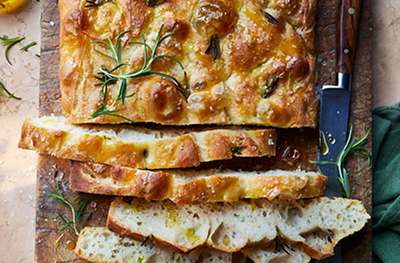
- Makes1
- CourseAccompaniment
- Prepare20 mins
- Cook25 mins
- Total time45 mins
- Plusresting and overnight proving
Ingredients
- 500g strong white bread flour
- 7g easy bake yeast sachet
- 1 tsp caster sugar
- 2 tsp fine salt
- 4 tbsp Italian extra virgin olive oil, plus extra for shaping
- 1 sprig/s rosemary
- 1 tsp sea salt flakes, to sprinkle
Method
Place the flour, yeast, sugar and salt into a large bowl and mix well to combine. Blend 2 tbsp olive oil with 400ml lukewarm water, then pour into the flour mixture and stir well to create a wet, sticky dough. It won’t be smooth or look like other bread dough – you’re just looking to briefly combine so no floury patches remain. Cover the bowl with a tea towel and leave to rest for 20 minutes. This allows the gluten to relax and prepare the dough for stretching and folding.
There are four stretch and fold motions to perform, at the top, bottom, left and right of the dough. Wet your fingers with water, then scoop and grip the edge of the dough at the top of the bowl. Stretch it vertically, then fold over the top of the dough, completely covering the ball with the stretched piece. Rotate the bowl 90º and repeat the stretch and fold motion 3 more times. You’ll be left with a parcel of dough – it won’t look smooth at this point but it will once it has risen.
Cover and leave to rise for 3-5 hours, repeating the stretch and fold process 3 more times during this period. By the fourth time, the dough will look smooth and uniform, and will jiggle when you shake the bowl. It should also have doubled in size. Try to space your stretch and folds evenly over the rising time, but don’t stress too much as the dough is forgiving.
Prepare a 30x23cm baking tin by drizzling with 1 tbsp olive oil. Tip the risen dough into the tin, coat in the oil and use oiled fingertips to spread it out, into the edges. If the dough is too stubborn to spread, leave in the tin for 20 minutes, then try again when the gluten has relaxed. Cover the tin, ideally with a reusable plastic bag, and refrigerate overnight for 8-12 hours.
In the morning, remove the tin from the fridge and allow the dough to come to room temperature (usually 2 hours). The metal tin should no longer be cool to the touch and the dough should be jiggly when shaken.
Preheat the oven to 230ºC, gas mark 8, and place an empty metal baking tin (any shape) near the bottom of the oven. Oil your fingertips, drizzle the dough with the remaining 1 tbsp olive oil, then dimple it all over, leaving recesses where your fingers have been to create bubbles. Pull small sprigs from the rosemary and push into some of the holes, then sprinkle the top generously with the sea salt flakes.
Pour a large mugful of water into the preheated baking tin in the oven to create steam (see tips), and place the focaccia in the centre of the oven. Bake for 20-25 minutes, until golden brown all over. Allow to cool briefly in the tin for 5 minutes, then transfer onto a wire rack and allow to cool completely. If you let it cool completely in the tin, the bottom of the loaf will be soggy.
Cook’s tip
How to pause
Making great bread is a hands-off but time-consuming process, and sometimes plans change. Bringing down the temperature delays the proving process, so buy a few hours by placing the dough into the fridge at any point during the proving process. Make sure you bring the dough back to room temperature before you attempt to bake it.
Adding steam
If your oven has a function that allows you to add steam during the bake, use it for this bread. If not, follow my instructions to add steam by pouring water into a separate baking dish in the oven. It delays the setting of the crust on the bread, allowing it to rise high before turning crisp.
Fresh is best
Double check the best before date on your yeast before baking. Old yeast nearing its use-by date will be less effective, so use as fresh as possible for the best rise.
Nutritional
Typical values per item when made using specific products in recipe
Energy | 814kJ/ 193kcals |
|---|---|
Fat | 5.2g |
Saturated Fat | 1.1g |
Carbohydrates | 30g |
Sugars | 1.2g |
Fibre | 1.8g |
Protein | 5g |
Salt | 1.3g |


